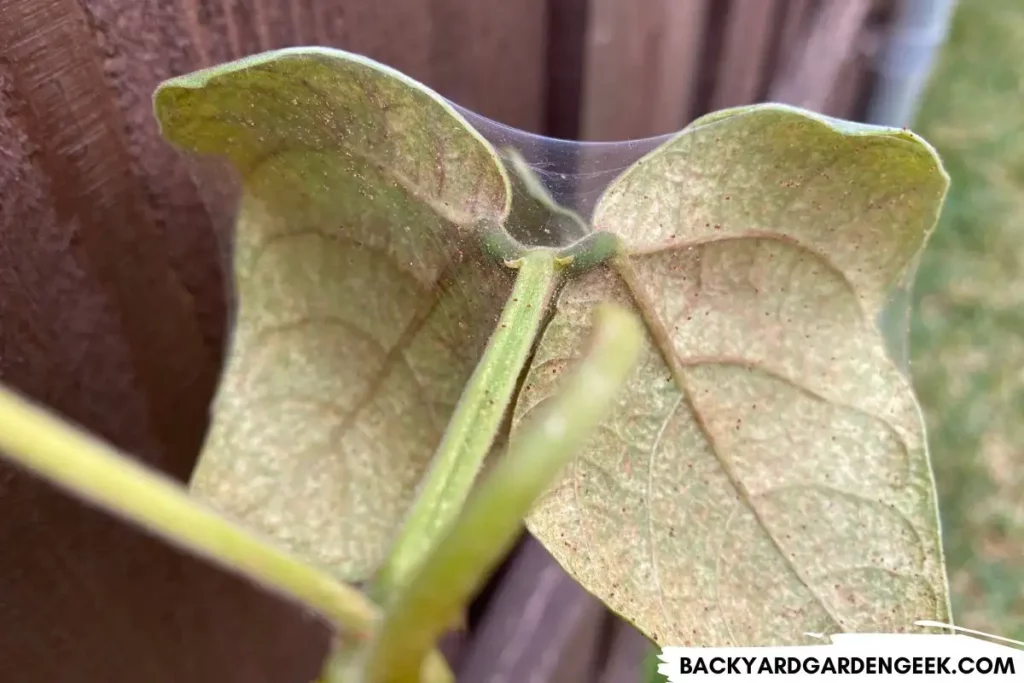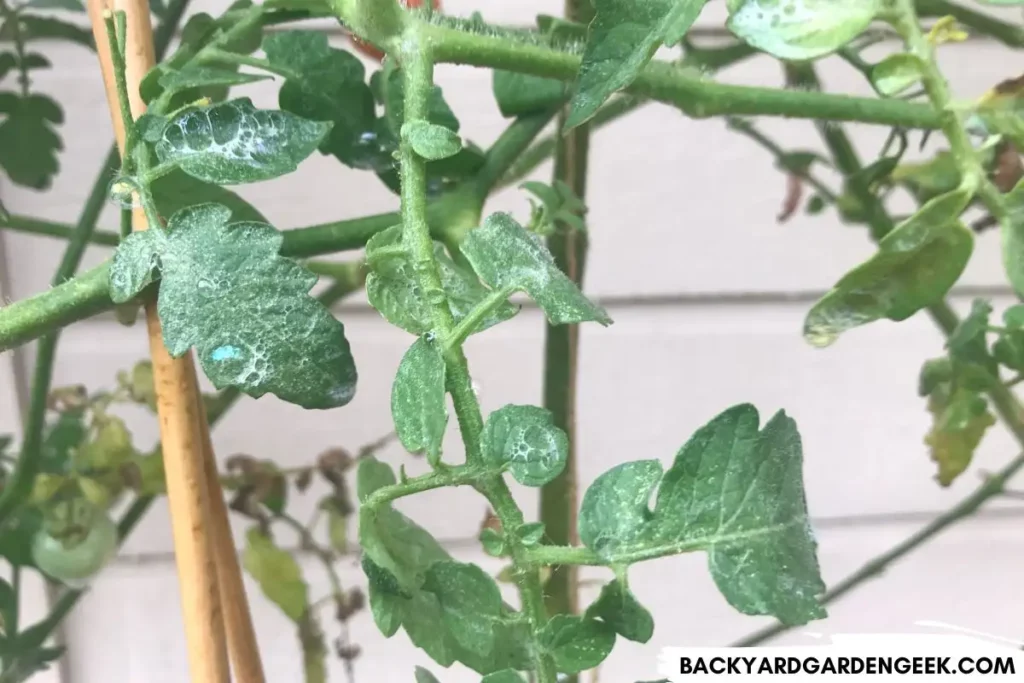Diatomaceous Earth and Spider Mites: Will DE Kill Them?
If you’ve seen spider mites in your garden, you might have wondered if diatomaceous earth (DE) will take care of your problem.
Will DE kill off or prevent spider mites?
Diatomaceous earth will kill spider mites due to its abrasive qualities, but DE is not an ideal pest control method since spider mites are microscopic pests that reproduce quickly. Soapy water and neem oil sprays are much more effective than DE at killing spider mites.
I’ve dealt with spider mites for many years, and they’re one of the smallest but most dangerous pests in the garden.
Unless you know exactly what to look for, you can easily overlook spider mites when they arrive, and if you don’t address the problem quickly, the mites will reproduce exponentially, spread across your garden, and literally suck the life and energy out of your plants.
In this article, I’ll do the following:
- explain why and how diatomaceous earth can kill spider mites.
- discuss why it’s not the most effective way to kill off spider mites.
- provide step by steps for killing off spider mites using soapy water and neem oil sprays.
Before we get going, here’s what I use in my backyard garden, so you’ll want to consider getting your hands on these products (or something like them) if you don’t already own them.
Now that I’ve covered the basics, let’s get started!
Can You Use Diatomaceous Earth to Get Rid of Spider Mites?

Diatomaceous earth (DE) provides a natural and chemical-free method to tackle the pesky issue of spider mites.
What’s the secret behind its bug-harming abilities? The trick is found in its unique physical structure.
DE consists of fossilized remains of tiny, aquatic organisms called diatoms. These organisms have hard cellular structures made out of silica, one of the only organisms on the planet that has a siliceous cellular makeup.
When collected and ground into a fine powder, DE has microscopic, razor-sharp edges—safe for mammals (including us humans), birds, amphibians, and reptiles but disastrous for insects and pests like spider mites.
When spider mites come into direct contact with DE, the sharp edges cut through their protective outer layer, and the DE begins absorbing any bodily moisture it comes into contact with.
This causes spider mites to dehydrate quickly and die, providing a non-toxic way to keep your plants pest-free.
I’ve got some concerns about using DE on spider mite-infested plants—which I’ll discuss below in more detail—but if you plan to do so, here’s what you’ll need to consider:
1. Direct Contact: DE’s effectiveness depends on direct contact with spider mites. These tiny microscopic pests hide on the undersides of leaves, which can make it very difficult to target them with DE unless you’re got a high-quality bulb duster and you’re very careful when applying the DE to your plants.
2. Heavy Infestations: For larger infestations, you’ll need to cover the entire plant with DE.
I did this once when several tomato plants were infested with flea beetles that I couldn’t stop with other methods; however, this isn’t ideal since DE can’t differentiate between harmful pests and beneficial bugs. You risk killing off helpful insects in your garden when you cover your plants with DE.
Despite these considerations, DE can still form part of an effective pest management strategy.

Here are some step-by-step tips to help you apply DE effectively:
1. Assess the Infestation: Before you start, assess the severity of the spider mite infestation. This will help you determine how much DE you need and where to apply it.
2. Prepare Your DE: Wear a mask to avoid inhaling the DE powder. I always wear gloves as well, and I’ll put on goggles too if there’s any wind since I don’t want DE blowing in my eyes.
Once you’ve taken care of these preparatory matters, fill a dust applicator with enough DE to get the job done.
Leftover DE can be left in the duster for the next time you need to use it.
3. Application: Apply the DE to the affected plants. Remember, DE only works on direct contact with spider mites, so you’ll need to focus the dust on the undersides of leaves and other hidden areas where the mites tend to hide.
4. Consistent Application: Spider mites reproduce quickly. You’ll need to reapply DE every few days until you no longer see signs of an infestation.
5. Consider the Weather: DE works best in dry conditions. If it rains, you’ll need to reapply the DE. And if you’ve just applied DE, please don’t spray water on your plants when watering.
If you do that, you’ll negate all the work you just did applying the DE to your plants.
6. Minimize Collateral Damage: As much as possible, you should try to target the DE on all spider mite hotspots (which can be more than you might think!). This will help limit the impact on beneficial bugs.
While diatomaceous earth may not be the solution for all spider mite problems, its non-toxic nature and effectiveness against spider mites make it a tool worth considering.
By the way, if you’re interested in DE’s impact on common garden bugs, you might want to take a quick peek at these related articles:
- Killing Aphids with Diatomaceous Earth: Is DE Effective
- Will Diatomaceous Earth Injure Bees or Butterflies?
- Will Diatomaceous Earth Harm or Kill Cucumber Beetles?
- Will Diatomaceous Earth Harm or Kill Earthworms?
Now that we’ve covered the basics, let’s look at how long DE takes to help with your spider mite problem.
How Long Does It Take for Diatomaceous Earth to Kill Spider Mites?

Let’s imagine you’ve just dusted your plants with diatomaceous earth and are waiting for the results.
But how long will it take for DE to do its job?
Once DE comes in direct contact with spider mites, it starts working immediately. The sharp-edged particles cut into the mites’ protective layer, initiating the dehydration process.
This isn’t an immediate death sentence since the complete dehydration process can take several hours for spider mites and 1-2 days for larger garden pests.
Now you might be thinking: “So I only need to apply DE once, then wait a few days, right?”
But here’s the kicker: Spider mites are notoriously adept at hiding, they proliferate quickly, and they’ll inhabit your plants by the thousands (even if it doesn’t look that way).
These microscopic pests tend to cluster on the underside of leaves, which makes it easier for them to escape your DE treatments.
This means that one application of DE won’t get all the mites.
(In fact, as I mention below, I don’t think you should attack spider mites with DE only. There are just too many of them and they hide too well.)
For DE to work on spider mites, you’ll need to maintain a regular application schedule.
A good rule of thumb is to reapply DE once per week. This consistent application helps ensure that you catch any spider mites you missed during your initial application.
Also, remember that DE isn’t water-resistant. Rain or watering your plants will wash away your DE, rendering it useless. If your plants get any water on them, it’ll be time to reapply DE.

Now that I’ve covered the details of using DE to kill spider mites, I’d like to share information about the 2 methods that have worked best for me over the years—soapy water and neem oil sprays.
But if you’ve learned something from the diatomaceous earth tips I’ve shared with you, you might be interested in reading these related articles:
- 11 Proven Ways to Stop, Kill, and Get Rid of Spider Mites
- 27 Plants that Resist, Repel, and Trap Spider Mites
- Are Spider Mites Spiders? How to Identify These Garden Pests
- Can Plants Recover from Spider Mites? What You Need to Know
- Do Marigolds Repel or Stop Spider Mites
What Is the Best Killer of Spider Mites?
Although diatomaceous earth offers a natural and non-toxic approach to pest control, it’s not my top choice when it comes to spider mites.
Why? Spider mites, with their microscopic size, rapid reproduction, and knack for hiding under leaves, can often avoid direct contact with DE, reducing its effectiveness.
Instead of using only DE, I prefer to use daily soapy water sprays, coupled with weekly neem oil sprays. I’ll add weekly DE applications for particularly extreme infestations.
For me, this approach is the most effective way to combat spider mites.
Soapy water sprays work by coating the mites and suffocating them, while neem oil acts as a potent deterrent, interrupting their life cycle and inhibiting their ability to feed and reproduce.
Here are the recipes I use in my garden:
Soapy Water Spray
- Add 5 tablespoons of Dr. Bronner’s Peppermint Castile Soap to a 1- or 2-gallon sprayer. I prefer 2-gallon sprayers since you can store soapy water spray for later use.
- Fill the sprayer with 1 or 2 gallons of water. Be sure to add the soap first, or you’ll have a foamy mess on your hands.
- Spray your plants thoroughly every day. Aim to coat the entire plant, paying special attention to the undersides of leaves where spider mites tend to hide.

Neem Oil Spray
- Use a 1/2 gallon or 1-gallon sprayer only. You can’t store neem oil, so you need to use it all up. There’s no need for a 2-gallon sprayer unless your garden is massive, which is why I prefer 1/2 gallon sprayers for neem oil applications.
- Mix 1 tablespoon of neem oil 1/2 gallon of water or 2 tablespoons of neem oil with 1 gallon of water.
- Add 1 tablespoon of Dr. Bronner’s Peppermint Castile Soap to act as an emulsifier, ensuring the oil and water mix well.
- Apply the neem oil spray to your plants once per week. As with the soapy water spray, aim for total coverage with a focus on the undersides of leaves.
- Be sure to spray your plants in the early evening to avoid burning them. Avoid mornings. I’ve done that before, and I’ve accidentally burned my plants.
Remember, spider mite infestations require persistence and consistency to control.
By using a daily soapy water spray and a weekly neem oil treatment—-combined with weekly or occasional DE applications—-you’re tackling the infestation from different angles and ensuring that spider mites don’t take over your garden.
If you’ve made it this far, you’re ready to wage a successful war against spider mites and keep your plants healthy and thriving. Here’s to pest-free gardening!
Additional Reading
If you’ve enjoyed learning more about the best ways to kill off spider mites, check out these related articles:
- 5 Reasons to Mix Diatomaceous Earth with Soil
- Best Way to Apply Diatomaceous Earth to Plants: 11 Pro Tips
- Can Diatomaceous Earth Harm Plants? What Scientists Say
- Can You Put Too Much Diatomaceous Earth on Plants?
- Diatomaceous Earth and Ladybugs: Will DE Kill Them?
- Using Diatomaceous Earth as a Fertilizer: Will DE Help?






